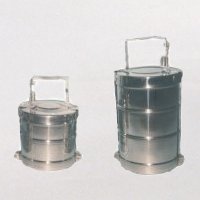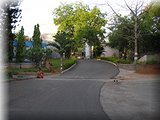

Of gajars and steel Tiffin boxes…
A self-prescribed diet has had somewhat satisfactory results for me (ask someone who has been plagued with three tiers around his stomach what it means to achieve two tierdom…) but this satisfaction came at a cost (whoever said that there is a free ride to success was probably blow jobbing his/her {isnt it wonderful to be politically correct is such contexts ...tee hee}way to glory)…and the cost came in the shape of a phallic root vegetable (there is an impressive term for root vegetables which I cant for the life of me remember)…gajar or carrot…
Much to the amusement of my chole bature (yumm), Chow chow (we Bengalis call noodles chow chow …we are a weird race aren’t we …sigh…) and alu paratha-devouring colleagues my tiffin comprises gajar and cucumber (and the fact that the box happens to be a quaint lil steel one doesn’t help either)…so obviously have managed to become a lunchtime outcast in the office (they crack gajar jokes behind my back) …sigh…
Social stigma apart gajar has been a bane of my existence in many different ways…it doesn’t suit my system you see…causes …errm… lets say …acidity…
So after much consultation (with my friendly neighborhood sabziwalla, who insists that he will provide me with a tastier, cheaper alternative) have decided that …
Its goodbye gajar
And hello radish…:)
Tuesday, August 29, 2006
Posted by serendipiduous at 12:27 PM 4 comments


An indignant Utpal Dutt to J. Om Prakash when he is wrongly accused of being a smuggler (those were the innocent days of smugglers, smugglers who would smuggle <>gold biscuits
An embarrassed Jaya Bhadhuri answers, when her elder sister questions her about the ring that her boy friend (who the sister thinks, is a married man) has given her (the ring has his initial -S)- “woh mera naam hain na Vasudha v-a-S-u-d-h-a usi ka S hai” (the S stands for the S in my name v-a-S-u-d-h-a) Chupke Chupke (1975)
Utpal Dutt wants to confront a petrified Dina Pathak but is faced with the Herculean challenge of being able to sit on the moving swing she is perched on. Gol Maal (1979)
Amol Palekar to Utpal Dutt (punning on the moustache imbroglio): "Aapke aur mere beech baal barabar bhi deewar na khadi ho paaye (No wall, not even one as thin as a strand of hair, should form a barrier between us)." Gol Maal (1979)
Hrishikesh Mukherjee the master of Wodehousian comedies is dead…
With him dies Bollywood’s ability to create a space where the middle class man/woman (oof am done being politically correct…waitaminute person seems good enough)…middle class person then J… could throw his/her/ their head back and laugh at himself/herself/themselves (pheww)
Bbye Hrishida (is it presumptuous of me to address him with this term of endearment??? And much too corny too don’t u think…. sigh….)
Posted by serendipiduous at 10:30 AM 0 comments
Thursday, August 24, 2006
Malaise
Disclaimer; any kind of judgment being passed on me based on my innermost thoughts will be incredibly unfair…on second thoughts go ahead judge me whatdoicare…hmmmph…
Its one of those days when u discover your fecundness (I wanted to use the word "prolificness" but this annoying MS word insists that there is no such word and innumerable embarrassing incidents have taught me that MS word is almost always right when it comes to spelling and words)…little failures make u think and ponder over your abilities, but if u are me they take u to this incredible pall of malicious gloom where you questions the ability of those around you and make you dismiss them without even giving them a flicker of a chance (oh he is this upstart wannabe who shamelessly sucks up to the boss, she isn’t even from a proper college… she is after all, ridiculously ugly and has to let her work speak for her)…. am hoping penning this down will help me come in terms with that very malaise of mine….
Posted by serendipiduous at 1:24 PM 2 comments

Desire des yeux
A rain swept office afternoon
And my glare stained eyes
Pines
For a splash of ciefl
Will you? Shall you? Can you?
Asks my weathered mind
As I gather the strength
To revert to a state of indecision
From a state of decaying status quo
Posted by serendipiduous at 11:46 AM 0 comments
Tuesday, August 22, 2006
The other day (people like me are infinitely grateful for such phrases as “other day”, makes our inability to remember dates seem so …philosophical) a friend of mine (well she is not exactly a friend, its just that a bunch of us got along very well when we met in Pune when we went there for an interview about 3 yrs ago and have bothered to keep in touch ever since) emailed me (well it was more of a group mail) saying how happy she was with her husband attached a few “hum saath saath hai” snaps of her family (she also very significantly and disturbingly attached a disclaimer to the mail which said that she knows that her husband is better looking than her and she is all the more happier for it)… this particular email was the latest in the series of Latvia ‘s (that’s obviously not her name but I love the ring of it, and yes I know it’s the name of a Balkan country, so I wanna pseudonym my friend after a country…kill me for it) “Great Indian Wedding” series…this particular series started about a year ago when Latvia (tee hee) suddenly out of blue, mailed announcing(much to our dismay) that she is getting married in a weeks time and will not continue with her mass comm. degree from a perfectly respectable institute (I specify the respectability of the institute coz its important for me) …much to the annoyance of the feminists in us she went on to say she obviously wont work after her marriage and will keep house for her “wonderful” husband….this mail was followed by other mails at regular intervals which kept us updated with each and every significant event of her married life…the stress was always on/ in (?) the happiness factor…she would never forget to mention how happy she was …now the cynic in me drew my own morbid conclusions-unhappy, unfulfilled life tantamount to a superficial show of happiness…add to that her “my husband better looking than me comment” and you have a minor tragedy in your hand ( my eyes actually did well up after reading that particular statement) but then is saw the snaps …and she did actually seem ….happy…and her husband really was…better looking (this may seem horrendously politically incorrect but he really was )…
So why then the need to constantly establish her happiness??? I decided to read through our exchanges…and found the answer…it was me...I made her do that (and maybe many other “so called” liberated friends of hers)…my cynicism was so palpable in my mails that its not funny…she was only trying to reassure us that she neednt live up to our definition of happiness to be happy …she has found happiness in what we may think to be a constricting life…who am I /we to question that…
Here is to u and your better-looking husband Latvia …may u always be “happy”….
Posted by serendipiduous at 11:39 AM 3 comments
Saturday, August 05, 2006
well...i work now...let me rephrase that... i write...
am supposedly a travel writer...
but i write about paintings...
surprised ???
well dont be...life is full of lil mishaps like me...
this is one of the sadder pieces i wrote ...but i like it coz its about an art form i was quite happy to discover...i wont go on about constrictive nature of writin for website (the repetitive use of certain keywords)
Thangka Paintings
Thangka Paintings are composite three-dimensional products of art, which derive their themes from Buddhist philosophies. They are essentially religious objects and are of great significance to the Tibetan Buddhists. These beautifully crafted banners are generally hung on monastery walls; they are also an integral part of Buddhist religious processions.
The Tibetan word “ Thang” means a flat surface, which when suffixed with “ ka ”( painting) means “a flat painting” or a “painting on a flat surface”. These paintings are generally done on flat surfaces but they offer the option of being rolled up when not being displayed, a la scroll paintings.
Thangka-the structure
A Thangka comprises a painted or embroidered picture panel, a mounting, which is further embellished with a silk cover, wooden dowels at the top and bottom, leather corners and beautiful metal or wooden decorative knobs on the bottom dowel.
The Philosophy behind the Thangka Paintings
Most art forms, specially the religious ones hardly ever follow the doctrine of artistic intent, rarely, if ever, do they display personal vision and creativity. The overwhelming Buddhist Philosophy dominates the theme and execution of these paintings. Little wonder that most Thangka Painters have remained anonymous, as have the tailors who have made the mountings.
Essentially, Thangkas are records or pictorial depictions of contemplative experiences. Buddhist monks when instructed by their teachers to imagine themselves in specific situation for meditations, use the Thangkas as their reference point.
The themes of Thangka Paintings
Most Thangka Paintings have the tri-dimensional Mandala as the centerpiece. A geometrical representation of the universe, the Mandalas, depicts the enlightened minds and souls of revered Buddhist monks. Most Mandalas have the venerated deity Vajrakaliya or Vajrakumara as the focal point. This fearful deity has the power to transform acts of cowardice and selfishness into acts of wisdom and compassion. He is considered to be a great source of will power for the monks who have to lead ascetic lives. Other religious deities and iconographies too find their place in this complex yet geometrically flawless mode of art.
Some Thangkas represent the deity Shakyamuni in different imaginary places like palaces and secluded monasteries.
Most of these paintings have a complex web of minor figures that signify different aspects of the dominant philosophy. One has to cross various levels of earthly temptations, spiritual redundancy and physical moorings, to reach the center of perfection, which is represented by the deity Shakyamuni. The colors and style of Thangka Paintings
Thangkas, primarily have black, gold and red backgrounds. Some however use multicolored backgrounds too, but they are a rarity. They are mostly painted on cotton canvases and the canvas is tempered with herbal solutions before the painting. The colors used are natural water-soluble pigments. Most Thangkas employ the mathematics of geometry to create systematic grids of angles and lines. These lines are embellished with colorful figures of monks, flora and fauna. The vast palate of colors is used but the dominant ones certainly has to be red, gold, orange and blue. Blue is the color to represent certain deities. The brushstrokes are delicate yet confident and these paintings are characterized by their fluidity.
Thangka Paintings in India
The ancient art of Thangka Paintings is practiced in Buddhist dominated areas of India. Dharmashala , which has a sizable settlement of Tibetans, can be called the hotbed of Thangka Painting in India.
The west has seen Thangka as nothing more than a decorative art piece for all these years this perception is thankfully changing as the west is gradually being sensitized to the Buddhist Philosophy.
Posted by serendipiduous at 11:47 PM 6 comments
